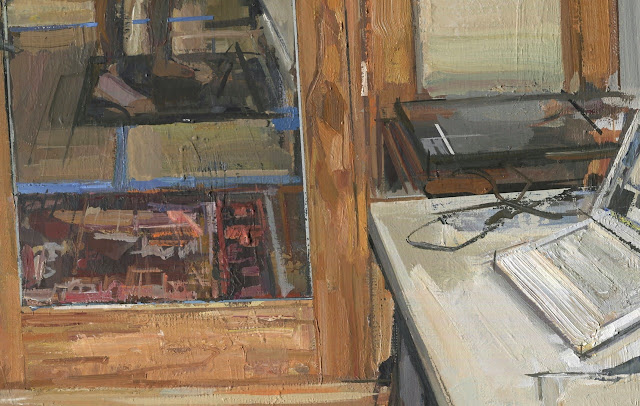
I started a new painting a few days ago, depicting a flowering bulb on our kitchen table. There are 5 flowers ready to bloom and, as of now, only 2 are fully opened. I'm waiting for the pinnacle of it's growth to paint that part, which should be in a few days. This probably means I'll have to get the flower done in 1 painting session, because of it's transient nature. Until now, I've mostly been working on other aspects of the painting, like the light and the space. It's really exciting capturing these slow, incremental movements of a plant's life cycle through time. (see the post I did about the banana palm painting) I'm beginning to feel Nature's slow, almost imperceptible growth all around me, through the paint.
The idea to do this painting came quite suddenly last week, after my wife Faith, moved the bulb from a corner of our kitchen onto the center of our table. I had sort of forgotten about it, as it had been slowly incubating there since Christmas. I'm always really impressed by her love and appreciation of plants, as well as, her excellent horticultural skills. Growing up as a kid, I was used to my mom placing plastic plants in unseen corners of our house where they would slowly accumulate dust (not such a green thumb). I love watching the slow passage of movement in a plant's growth cycle, as well as the bursts of bright colors that are sprinkled throughout our house and yard. It makes me aware of how dense and full of life the world really is.
I didn't do any prep studies for this one, but just grabbed a canvas I had in my studio and started painting. Usually I like to do some drawings and sketches first, to determine the composition and size of the painting. Recently, I've been determining my canvas size through drawing; working out from my field of vision, rather than having to fit what I see into the parameters of a pre-determined canvas size. This one is an unusual proportion for a still life, 14" x 22". Last Fall, I made a bunch of wide canvases like this to use for my quick, plein air landscapes. I like the wider format, as it is helping to re-emphasize the sweeping expanse of the horizontal table in front of me. I'm recording the slight bend and sag of the table as it sweeps away from the focal point of my vision, the flowering bulb.
Behind the bulb, is one of my wife's paintings. An initial impulse in painting this scene was how the flower was eventually going to mimic the colors and forms in her painting. We both feel that it's one of her best pieces, which is why it hangs over our kitchen table. By including her work in mine, it is bringing our paintings into a new dialog; a fuller relationship of the interconnectedness of our art and life together.






